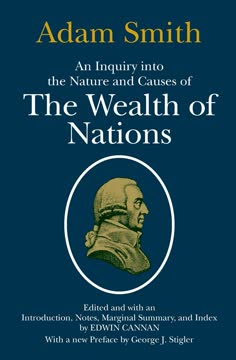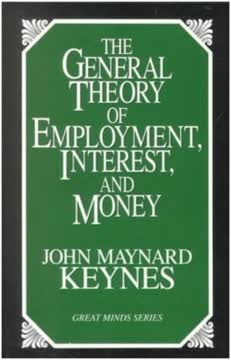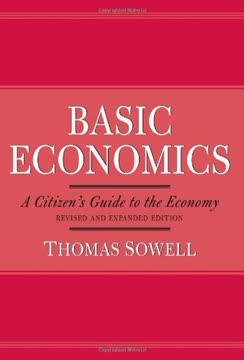Key Takeaways
1. Economics is about scarcity and trade-offs, not just money
Economics is the study of the use of scarce resources which have alternative uses.
Scarcity drives choices. Economics examines how societies allocate limited resources among competing needs and wants. This applies to individuals, businesses, and governments alike. Every choice involves trade-offs - selecting one option means giving up another.
Not just about money. While money is often involved, economics also studies non-monetary resources like time, labor, and natural resources. For example:
- A student choosing between studying and socializing
- A government deciding how to allocate healthcare funding
- A company determining how to use limited factory capacity
Opportunity cost. The true cost of any decision is what you give up by making that choice - the next best alternative foregone. Understanding opportunity costs helps make better decisions by considering all implicit and explicit costs.
2. Prices coordinate resource allocation efficiently
Prices are like messengers conveying news-sometimes bad news, in the case of beach-front property desired by far more people than can possibly live at the beach, but often also good news.
Price signals. In a market economy, prices act as signals conveying information about relative scarcity and demand. High prices indicate scarcity or high demand, encouraging:
- Increased production
- More efficient use of the resource
- Development of alternatives
- Reduced consumption
Coordinating mechanism. Prices allow millions of independent decision-makers to coordinate their actions without central planning. For example:
- Rising oil prices spur conservation and alternative energy development
- Falling computer prices enable wider adoption of technology
Rationing function. When supply is limited, prices ration scarce resources to those who value them most highly, as measured by willingness to pay. This ensures resources flow to their highest-valued uses.
3. Price controls often have unintended negative consequences
Shortages mean that the seller no longer has to please the buyer.
Disrupting market signals. When governments impose price ceilings or floors, they interfere with the market's ability to balance supply and demand. This often leads to:
- Shortages (with price ceilings)
- Surpluses (with price floors)
- Reduced quality
- Black markets
Real-world examples:
- Rent control leading to housing shortages and deteriorating quality
- Minimum wage potentially reducing employment opportunities
- Agricultural price supports creating costly surpluses
Unintended effects. While price controls are often implemented with good intentions, they frequently harm the very people they aim to help by reducing supply, quality, or access to goods and services.
4. Profits and losses drive economic efficiency
Failure is part of the natural cycle of business. Companies are born, companies die, capitalism moves forward.
Market feedback. Profits and losses provide crucial feedback about how well businesses are meeting consumer needs and using resources efficiently. This drives:
- Innovation
- Productivity improvements
- Reallocation of resources to more valued uses
Creative destruction. The constant churn of businesses entering and exiting markets is essential for economic progress. Examples:
- Blockbuster replaced by Netflix
- Kodak disrupted by digital photography
- New startups challenging established industries
Incentives matter. The profit motive encourages:
- Risk-taking and entrepreneurship
- Efficient use of resources
- Responsiveness to consumer preferences
Without the possibility of profits, there would be less incentive for innovation and efficiency improvements that drive economic growth.
5. Labor markets are shaped by productivity and human capital
What people are paid does not depend on how much the payers like them personally or how much income the payers think they need or deserve. It depends on how much other people are willing to pay for their work.
Productivity determines wages. In competitive markets, workers tend to be paid according to their marginal productivity - the additional value they create. Factors affecting productivity include:
- Skills and education (human capital)
- Technology and capital equipment
- Management practices
Human capital investment. Improving skills and knowledge through education and training increases a worker's productivity and earning potential. This explains wage differences across:
- Education levels
- Occupations
- Experience levels
Supply and demand. Like other markets, labor markets are influenced by supply and demand. Wages tend to be higher for:
- Scarce skills
- Unpleasant or dangerous work
- Jobs requiring extensive training or education
Understanding these factors helps explain wage differences and guides personal decisions about education and career choices.
6. Financial markets and institutions facilitate economic growth
Financial institutions allow individuals who do not know each other to use one another's incomes to redistribute their own incomes over time, in effect drawing on future income to pay for current purchases, or alternatively postponing purchases till a later time, when the interest received will enable larger purchases to be made.
Intermediation. Financial institutions like banks act as intermediaries between savers and borrowers. This enables:
- Efficient allocation of capital to productive uses
- Risk sharing and diversification
- Maturity transformation (short-term deposits funding long-term loans)
Investment and growth. Well-functioning financial markets support economic growth by:
- Funding business expansion and entrepreneurship
- Enabling large-scale projects (e.g., infrastructure)
- Facilitating home ownership and consumer purchases
Types of financial instruments:
- Stocks (equity ownership)
- Bonds (debt)
- Bank deposits and loans
- Insurance products
- Derivatives
These instruments allow for risk management, investment, and the efficient allocation of capital across the economy.
7. Government plays a crucial role in providing economic foundations
The most basic function of government is to provide a framework of law and order, within which the people can engage in whatever economic and other activities they choose, making such mutual accommodations and agreements among themselves as they choose.
Rule of law. A stable legal framework is essential for economic activity. This includes:
- Enforcing contracts
- Protecting property rights
- Maintaining a stable currency
- Providing national defense and public safety
Public goods. Governments provide goods and services that markets struggle to supply efficiently, such as:
- Infrastructure (roads, bridges)
- Basic research
- Environmental protection
Market failures. Government intervention can address:
- Externalities (e.g., pollution)
- Natural monopolies
- Information asymmetries
While government action can improve economic outcomes in these areas, it's important to consider potential unintended consequences and the limitations of government action.
8. International trade benefits countries through comparative advantage
A country does not need to have an absolute advantage in anything in order to prosper from international trade. It needs only to have a comparative advantage.
Specialization and trade. Countries benefit by specializing in goods they can produce relatively more efficiently and trading for other goods. This leads to:
- Increased total production
- Lower prices for consumers
- Access to a wider variety of goods
Comparative advantage. Even if one country is more efficient at producing everything, both countries still benefit from trade by focusing on their areas of relative strength. For example:
- A lawyer who's also a faster typist than their secretary still benefits from delegation
- A developed country trading with a developing nation
Protectionism pitfalls. Restricting trade through tariffs or quotas typically:
- Raises prices for consumers
- Reduces economic efficiency
- Invites retaliation from trading partners
While trade can cause short-term disruptions for some industries, the overall benefits to the economy generally outweigh these costs.
9. Economic policies have both seen and unseen effects
The first lesson of economics is scarcity: There is never enough of anything to satisfy all those who want it. The first lesson of politics is to disregard the first lesson of economics.
Intended vs. unintended consequences. Economic policies often have effects beyond their stated goals. It's crucial to consider:
- Short-term vs. long-term impacts
- Direct effects vs. indirect effects
- Concentrated benefits vs. diffuse costs
Examples of unintended consequences:
- Minimum wage laws potentially reducing employment opportunities
- Rent control leading to housing shortages
- Agricultural subsidies distorting global markets
Importance of economic literacy. Understanding basic economic principles helps citizens and policymakers:
- Evaluate policy proposals more critically
- Recognize trade-offs and opportunity costs
- Anticipate potential unintended consequences
By considering both the seen and unseen effects of policies, we can make more informed decisions about complex economic issues.
Last updated:
FAQ
What's Basic Economics: A Citizen's Guide to the Economy by Thomas Sowell about?
- Introduction to Economics: The book provides a comprehensive introduction to economic principles, focusing on their application in real-world scenarios. It avoids technical jargon, making it accessible to readers without an economics background.
- Focus on Scarcity: Sowell emphasizes that economics is about the allocation of scarce resources with alternative uses, highlighting the importance of scarcity in decision-making.
- Consequences Over Intentions: The book encourages evaluating economic policies based on their incentives and long-term consequences rather than intentions, offering a practical perspective on economic decisions.
Why should I read Basic Economics by Thomas Sowell?
- Clear Understanding: It offers a straightforward understanding of economic principles that affect everyday life, without complex theories.
- Practical Examples: Sowell uses vivid examples from various economies and historical contexts to illustrate key concepts, making them relatable and easier to understand.
- Informed Decision-Making: The book equips readers with the knowledge necessary to make informed decisions as voters and consumers, helping navigate political rhetoric and media discussions.
What are the key takeaways of Basic Economics by Thomas Sowell?
- Role of Prices: Prices are crucial in allocating resources efficiently in a market economy, acting as messengers conveying news about supply and demand.
- Importance of Profits and Losses: Profits incentivize innovation and cost reduction, while losses prompt businesses to reassess practices, ensuring efficient resource use.
- Consequences of Price Controls: Price controls can lead to shortages and surpluses, disrupting the natural signaling mechanism of prices and causing inefficiencies.
How does Basic Economics by Thomas Sowell define economics?
- Scarcity and Resource Allocation: Economics is defined as "the study of the use of scarce resources which have alternative uses," emphasizing scarcity's central role.
- Focus on Consequences: It involves understanding the consequences of various economic policies and systems, not just financial transactions.
- Broader Application: Economic principles apply across different systems, underscoring their relevance in various contexts.
How do prices function in a market economy according to Basic Economics?
- Signal Supply and Demand: Prices signal the relationship between supply and demand, guiding producers and consumers in their decisions.
- Guide Resource Allocation: They help allocate resources to their most valued uses by reflecting consumer preferences.
- Impact of Price Controls: Government-controlled prices disrupt this signaling, leading to inefficiencies like shortages or surpluses.
What are the consequences of price controls as explained in Basic Economics?
- Shortages and Surpluses: Price controls can lead to shortages when set too low and surpluses when set too high.
- Inefficiency in Resource Use: They result in inefficient resource allocation, preventing market adjustments to consumer needs.
- Historical Examples: Sowell provides examples like rent control to illustrate the negative effects of price controls.
How do profits and losses drive economic efficiency in Basic Economics?
- Incentives for Efficiency: Profits incentivize businesses to innovate, while losses force them to reassess practices.
- Resource Allocation: Profits and losses help allocate resources to their most productive uses, prompting necessary changes.
- Market Dynamics: The competitive nature of markets ensures businesses must adapt to survive, leading to a more efficient economy.
What is the significance of competition in economics according to Basic Economics?
- Driving Innovation: Competition encourages businesses to innovate and improve products to attract customers.
- Consumer Benefits: It benefits consumers by providing more choices and better prices, improving living standards.
- Market Efficiency: Competition ensures efficient resource allocation, as firms that cannot compete are forced out.
How does Basic Economics by Thomas Sowell address the role of government in the economy?
- Government Intervention: Sowell discusses the pitfalls of government intervention, such as inefficiencies and unintended consequences.
- Regulatory Commissions: He examines how these agencies can stifle competition and innovation by protecting existing firms.
- Anti-Trust Laws: Sowell critiques these laws, emphasizing the importance of allowing competition to dictate market outcomes.
What are some common misconceptions about economics according to Basic Economics?
- Misunderstanding of Profits: Profits are often seen as excessive charges rather than essential incentives for efficiency.
- Scarcity Misconceptions: Some believe abundance negates scarcity, but Sowell asserts scarcity is always present.
- Role of Prices: Prices are misunderstood as obstacles rather than vital signals in the economy.
How does Basic Economics explain the concept of supply and demand?
- Fundamental Economic Forces: Supply and demand determine prices in a market economy, with prices rising when demand exceeds supply.
- Impact of Price Controls: Government-imposed price controls disrupt the balance, leading to shortages or surpluses.
- Real-World Examples: Sowell uses examples to illustrate how changes in supply and demand affect goods and services.
What is the concept of comparative advantage in Basic Economics?
- Definition of Comparative Advantage: It refers to producing goods at a lower opportunity cost, underlying the benefits of trade.
- Mutual Gains from Trade: Specialization based on comparative advantage leads to increased efficiency and wealth.
- Real-World Examples: Sowell uses examples like NAFTA to show how comparative advantage operates and contributes to growth.
Review Summary
Basic Economics receives high praise for its clear explanations of economic principles without jargon or graphs. Many reviewers recommend it as essential reading for voters and students. Sowell's free-market perspective is appreciated by some but criticized as biased by others. The book covers topics like price controls, minimum wage, and international trade, using real-world examples to illustrate concepts. While some find it eye-opening, others caution that it presents a one-sided view of economics and should be balanced with other perspectives.
Similar Books










Download PDF
Download EPUB
.epub digital book format is ideal for reading ebooks on phones, tablets, and e-readers.











